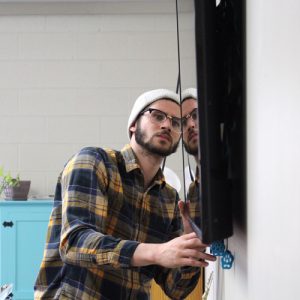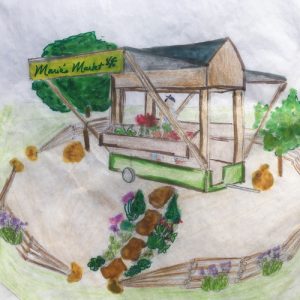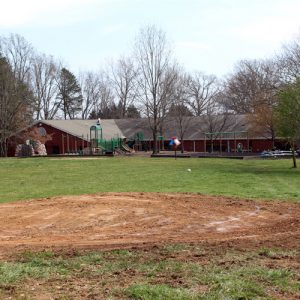Along with the revitalization of the Primary Classrooms that already happened in January, classroom grants are another big part of The Fund For GMS. The student-faculty-staff committee met over the winter and made decisions about the classroom grants funded by this annual drive, and we are now actively working on bringing those grants to fruition. With record-breaking parent participation and 100% participation from faculty, staff, and the board, we are delighted to announce our 10 grants from 70 in 70: The Fund for GMS. Each grant fits into one of three categories which organically emerged among the winners: Technology, Curricular Enrichment, and Outdoor Play.
Technology

Greensboro Montessori School's director of information technology installs a new UHD TV in the Junior High language arts classroom.
Collaborative learning through technology: All of Greensboro Montessori School’s Elementary and Junior High programs, serving grades one through nine, now benefit from state-of-the-art projection systems. In addition to our five existing SMART Boards, we now have six new mounted 55” ultra-high-definition (UHD) televisions, each accompanied by Apple TV 4K units. This technology system allows for wireless sharing and projection of educational programming from the School’s suite of MacBook computers and iPad devices. In addition to serving students, the systems can be used for staff meetings, parent gatherings, and other functions.
Real-time science demonstrations: Last fall our seventh- and ninth-grade students visited the Duke University Marine Laboratory where they spent hours of their own volition using a microscope which broadcasted to a high-definition television (watch the video of their fun here). Everyone in the classroom could view what was being seen under the microscope with breathtaking clarity. This system is now installed in our science laboratory, along with a new set of six high-quality dissecting microscopes which were recently used for shark dissection in Upper Elementary.
Functional technology in Lower Elementary: Our Lower Elementary classrooms are the beneficiaries of a charging station for their iPad devices and a shared printer. Prior to this technology grant, students using the School’s Read&Write literacy software had no access to print their work. Hence, teachers had to transfer and print any work done by students in the administrative office. With their own printer, students can independently complete their work which maximizes the benefit of their software.
Curricular Enrichment

A permaculture design sketch of the permanent home for Maria's Market.
A permanent home for Maria's Market: Junior High students at Greensboro Montessori School have multiple opportunities to delve into the study of economics through entrepreneurial experiences in both individual and group projects. Through their careers program, Students operate a micro-economy, which includes finance; management (student council), farming; culinary arts (restaurant); research, design and production; and yearbook. Farming, more casually called the farm team, is in charge of harvesting produce and eggs which they sell to restaurant for profit. Through a venture called Maria’s Market, they also sell to the public. A grant from The Fund for GMS will create a permanent home for a farm stand (which was built by the research, design, and production team) from which Maria’s Market will be open for business on select Friday afternoons.
Creativity on display: In a recent blog post about our Music Ensemble program, Upper School faculty, Jonathan McLean, noted how the daily integration of the arts is “something vitally different that we do here at Greensboro Montessori School.” A new gallery-style art hanging system in the Upper School will give creative works a new way to shine. The professional display system will further elevate art programming and pave the way for formal exhibitions in the future.
More functional (and beautiful) outdoor classrooms: In The Secret of Childhood, Dr. Maria Montessori writes: “There must be provision for the child to have contact with nature, to understand and appreciate the order, the harmony and the beauty in nature… so that the child may better understand and participate in the marvellous things which civilization creates.” Our permaculture gardens are one of the primary ways our students interact with nature, and recent investments made possible through The Fund for GMS have greatly enhanced these spaces. Chalk boards provide a space for displaying messages, lessons, and recipes. Scattered Adirondack chairs encourage small group work and reflection. A fence panel gracefully hides the HVAC units. And, a child-accessible tool shed in Lower Elementary builds students’ confidence, independence, and efficiency.
Outdoor Play

The leveled site for the Gaga Ball Pit, looking back over the athletic field toward the Upper School.
Going gaga for Gaga (Gaga Ball, that is): The Montessori method promotes physical movement as a path to improved mental cognition. It’s no wonder our Upper Elementary students are clamoring for a Gaga Ball pit, and thanks to The Fund for GMS, they will soon have one. The Gaga Center in New York City describes Gaga as “a fast paced, high energy sport played in an octagonal pit … Dubbed a kinder gentler version of dodgeball, the game is played with a soft foam ball, and combines the skills of dodging, striking, running, and jumping, while trying to hit opponents with a ball below the knees. Players need to keep moving to avoid getting hit by the ball. Fun and easy, everyone gets a serious workout.” Greensboro Montessori School’s Gaga Ball pit will be installed near the center of campus, nestled between the athletic field, Lower Elementary garden and Primary CASA playard.
Increased accessibility to soccer: We’ve replaced our outdated, tremendously heavy soccer goals with contemporary goals featuring 4-inch round aluminum uprights and crossbar with a white powder-coat finish. Not only are these goals durable and cleanly designed, they are easy to move making soccer more accessible to students and extending the life of our athletic field. Rather than taking the goals down immediately following the soccer season to protect the field, we can easily relocate the goals to the side line. This move shifts shooting away from the 18-yard box (the high traffic area around the goals) and allows Primary and Elementary students to continue using the goals well into fall.
Keeping sand in its place: The Tod Squad, as our Toddler faculty are affectionately called on campus, noticed their sandbox experiencing recurring issues with large quantities of mulch and rainwater flooding into the area and covering the sand. They requested wooden edging around the perimeter of their sandbox to preserve the longevity and quality of the sand (and the Toddler’s sand work, in general). This edging has already been installed, and our youngest students love their enhanced space.
Growing a vine tipi in Toddler: The Toddler play yard is full of fun, but also lots of sun. By berming up the perimeter around the Toddlers’ bamboo tipi, our environmental faculty can train some vines onto it, thereby creating a natural, shaded area for the students to play in and enhancing the beauty of our play area. Annual vines will be planted first, and more hardy, permanent perennials will be planted next.


